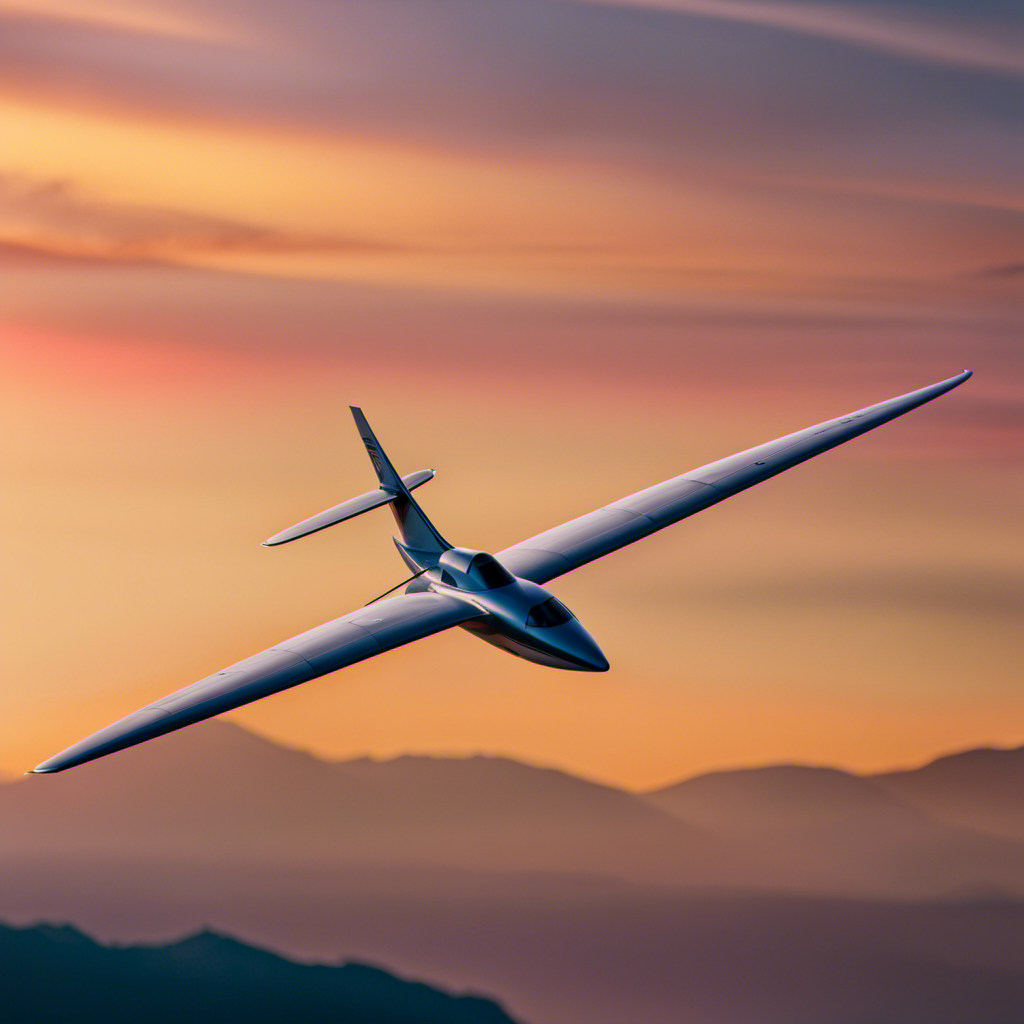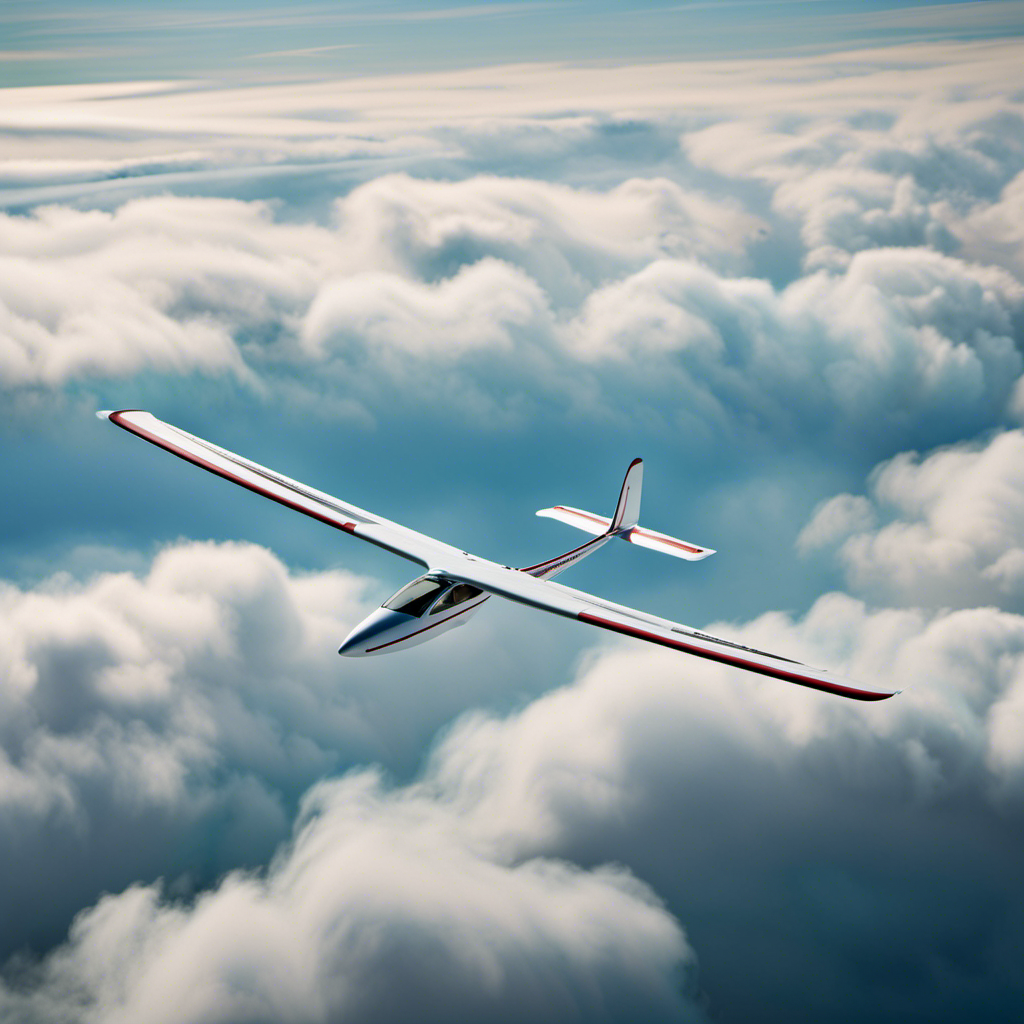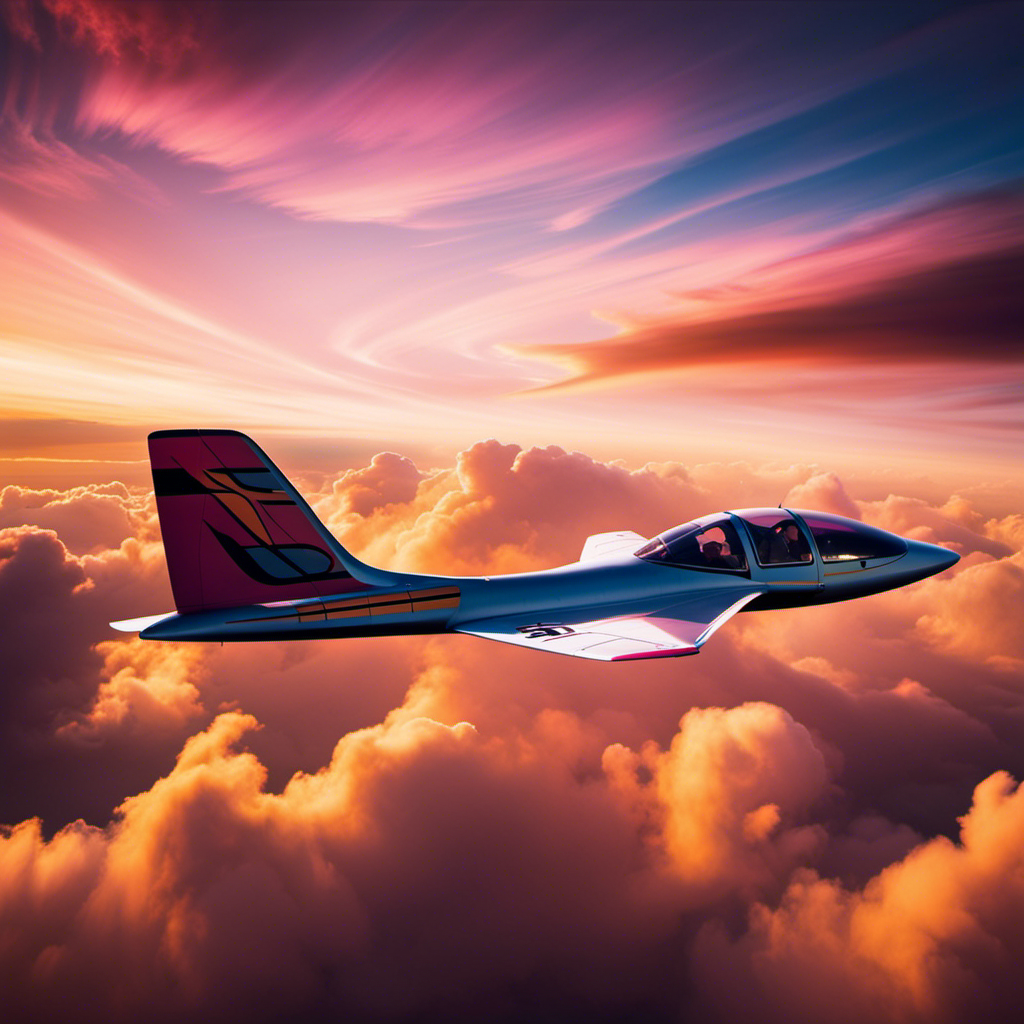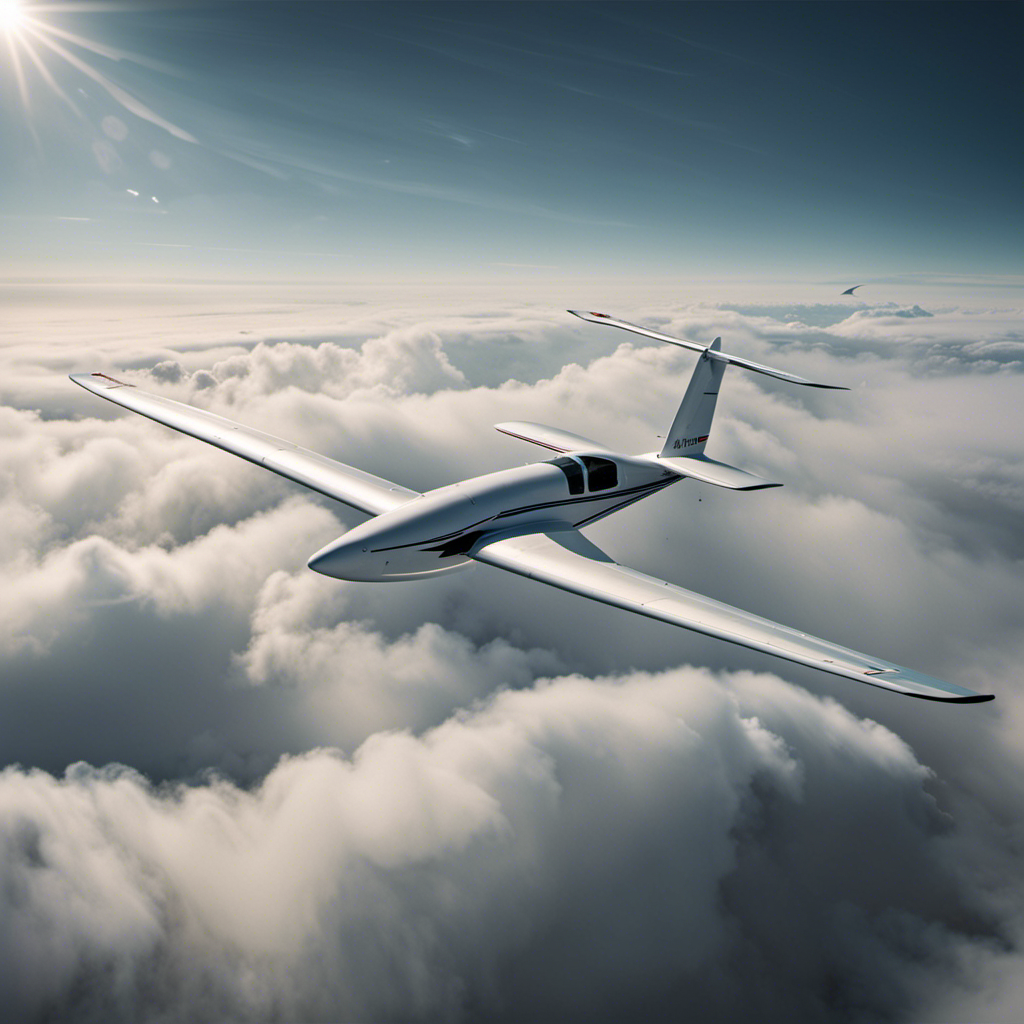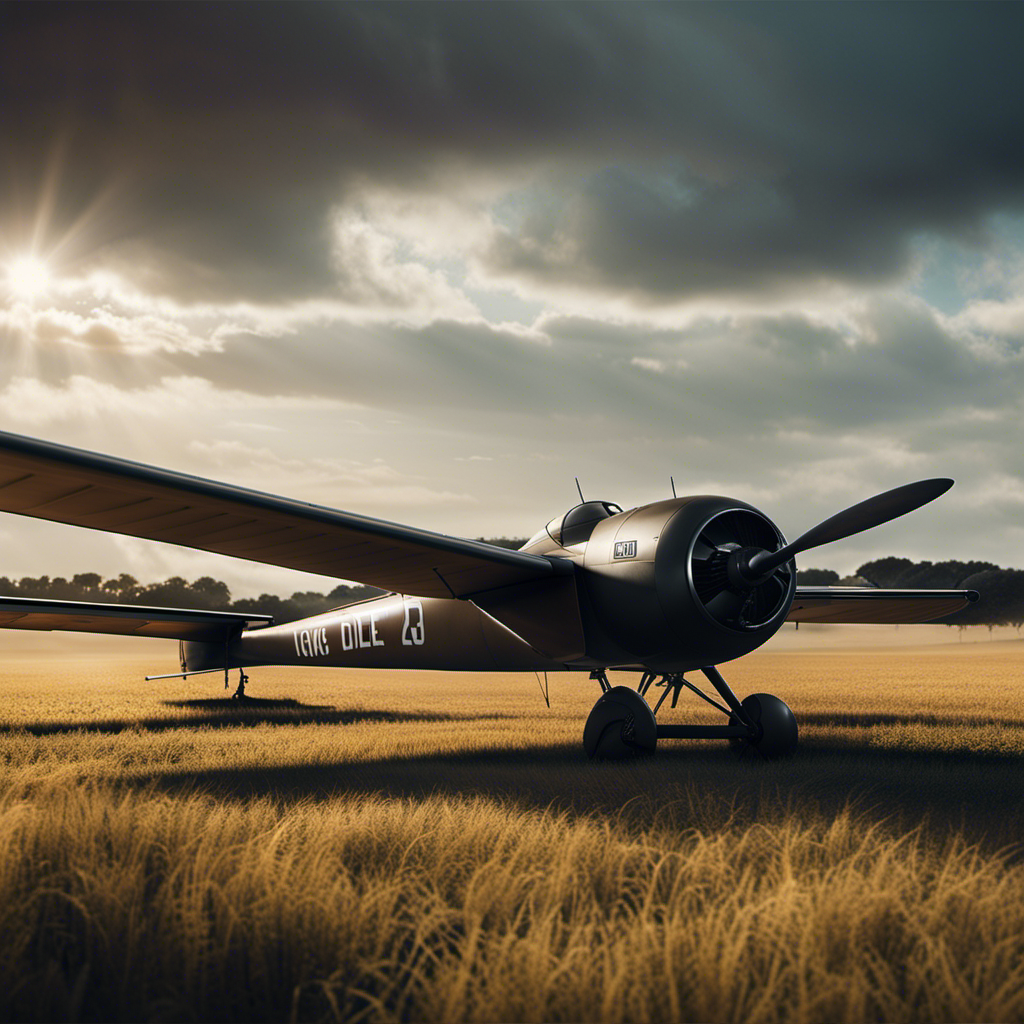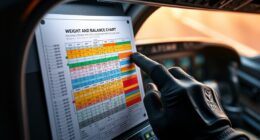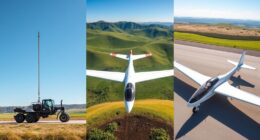As a glider pilot, I can confidently state that gliders appear to defy the laws of physics. These remarkable aircraft, despite being heavier than air, have the ability to soar through the sky without any engine assistance.
In this article, we will delve into the principles of aerodynamics that make glider flight possible. From understanding lift and drag to mastering weight distribution, we will explore the intricate details that allow gliders to gracefully navigate the skies.
So buckle up and prepare for a journey into the world of gliders, where the impossible becomes reality.
Key Takeaways
- Gliders fly without an engine, defying the laws of physics.
- Glider wings, called airfoils, create a pressure difference for lift.
- Understanding lift and drag is crucial for glider efficiency.
- Gliders utilize natural phenomena such as thermals and updrafts for sustained flight.
The Principles of Aerodynamics in Glider Flight
You’ll learn how the principles of aerodynamics play a crucial role in glider flight. Glider efficiency is heavily dependent on the understanding and manipulation of aerodynamic forces.
To achieve lift, gliders rely on the Bernoulli’s principle, which states that as the speed of a fluid (in this case, air) increases, its pressure decreases. This principle is applied through the shape of the glider’s wings, called airfoils, which are designed to create a pressure difference between the upper and lower surfaces of the wing. This pressure difference generates lift, allowing the glider to stay aloft.
Additionally, glider efficiency is enhanced by minimizing drag, which is achieved by reducing the glider’s frontal area and streamlining its shape.
How Gliders Stay Aloft Without an Engine
One way they stay aloft without an engine is by using rising air currents. Gliders are designed to take advantage of these natural phenomena, allowing them to soar through the sky with remarkable efficiency.
Glider performance is highly dependent on the skill of the pilot and the condition of the aircraft. Regular glider maintenance is crucial to ensure optimal performance and safety. This includes inspecting and repairing any damage, checking the control surfaces and instruments, and maintaining the structural integrity of the glider.
The Role of Lift and Drag in Glider Flight
Understanding the role of lift and drag is essential in achieving sustained and controlled flight in gliders.
Lift is the force that opposes the weight of the glider and allows it to stay aloft. It is generated by the principles of Bernoulli’s equation and Newton’s third law of motion. The shape of the wing, known as airfoil, is designed to generate lift by creating a pressure difference between the top and bottom surfaces.
Drag, on the other hand, is the resistance encountered by the glider as it moves through the air. It is caused by factors such as air friction and the shape of the glider. Minimizing drag is crucial to optimize the performance and efficiency of the glider.
By understanding the principles of lift and the importance of drag, pilots can make precise adjustments to achieve optimal flight conditions.
This understanding leads us to the subsequent section about the importance of weight distribution in gliders.
The Importance of Weight Distribution in Gliders
To achieve stable flight in a glider, it’s important to ensure proper weight distribution throughout the aircraft. The importance of weight distribution cannot be overstated in glider design. It plays a crucial role in determining the glider’s stability and maneuverability.
The center of gravity (CG) is a key factor in weight distribution. The CG is the point where the aircraft’s weight is considered to be concentrated. It is essential to position the CG within a specific range to maintain stability.
If the CG is too far forward, the glider may become nose-heavy and difficult to control. On the other hand, if the CG is too far back, the glider may become tail-heavy and prone to instability.
Understanding the center of gravity in glider design is fundamental to achieving optimal weight distribution and ensuring safe and efficient flight.
Understanding the Center of Gravity in Glider Design
The center of gravity in glider design plays a crucial role in determining stability and maneuverability. Ensuring that the center of gravity is properly positioned is essential for maintaining stability during flight. The center of gravity stability is achieved by carefully distributing the weight of the glider and accounting for the shifting of the center of gravity during different flight maneuvers.
Weight shift control is used to adjust the position of the center of gravity, allowing the pilot to control the glider’s pitch and roll. By shifting their body weight, the pilot can shift the center of gravity, influencing the glider’s response to control inputs. This weight shift control mechanism is a critical aspect of glider design, enabling pilots to maintain stability and achieve precise maneuverability in flight.
Transitioning into the subsequent section, the role of wing shape and angle of attack in glider flight is another important factor to consider.
The Role of Wing Shape and Angle of Attack in Glider Flight
Now, let’s discuss how wing shape and angle of attack affect your glider’s flight performance.
The wing shape and angle of attack play crucial roles in determining the wing efficiency and lift generation of a glider.
The shape of the wing affects the amount of drag experienced by the glider, with a sleek and tapered wing reducing drag and increasing efficiency.
Additionally, the angle of attack, which is the angle at which the wing meets the oncoming air, affects the lift generation. By adjusting the angle of attack, the pilot can control the amount of lift generated, allowing for changes in altitude and maneuverability.
Understanding and optimizing these factors is essential for achieving optimal flight performance in a glider.
As we delve further into how gliders utilize thermals and updrafts for sustained flight, we will see how these factors interact with the environment.
How Gliders Utilize Thermals and Updrafts for Sustained Flight
In our previous discussion on the role of wing shape and angle of attack in glider flight, we explored the foundational principles behind achieving lift and maintaining altitude. Now, let’s delve into how gliders utilize thermals and updrafts for sustained flight.
Thermals, pockets of warm air that rise in the atmosphere, play a crucial role in glider flight. Glider pilots employ thermal soaring techniques to locate and utilize these updrafts. By circling within a thermal, glider pilots can gain altitude and extend their flight time.
Strategies for maximizing glider flight time using updrafts include careful observation of cloud formations and studying ground features that indicate the presence of thermals. Skillful management of thermals allows glider pilots to stay aloft for extended periods, even without a motor.
Understanding thermal soaring techniques and strategies is essential for glider pilots aiming to master the art of maximizing flight time. However, the effect of wind and weather conditions on glider performance must also be considered.
The Effect of Wind and Weather Conditions on Glider Performance
To maximize your glider performance, you’ll need to consider how wind and weather conditions can affect your flight. The effect of wind speed and the impact of weather conditions are crucial factors that can significantly influence the performance of a glider. Wind speed determines the glider’s groundspeed and its ability to maintain altitude. A headwind can reduce groundspeed and make it more challenging to maintain lift, while a tailwind can increase groundspeed and potentially make landings more difficult. Weather conditions such as temperature, humidity, and atmospheric pressure can affect air density, which in turn affects lift and glide ratio. For example, high temperatures can decrease air density, resulting in reduced lift and decreased glider performance. Understanding and adapting to these variables is essential for successful glider flight.
| Weather Condition | Effect on Glider Performance |
|---|---|
| Wind Speed | Affects groundspeed and lift |
| Temperature | Influences air density |
| Humidity | Affects air density |
| Atmospheric Pressure | Impacts lift and glide ratio |
Considering the effect of wind and weather conditions, it is important to acknowledge the advantages and limitations of glider flight.
The Advantages and Limitations of Glider Flight
Understanding the advantages and limitations of glider flight is crucial for pilots. Gliders offer several advantages over powered aircraft. Firstly, they have a longer range as they can stay aloft for extended periods using only the natural forces of lift. This makes gliders ideal for cross-country flying and exploring new areas. Additionally, gliders have a lower operating cost compared to powered aircraft since they do not require fuel.
However, there are limitations to glider flight. One major limitation is their inability to take off on their own. They rely on being towed into the air or launched from a high point. Furthermore, gliders are highly dependent on weather conditions, with their performance being greatly affected by wind speed and direction.
Transitioning to the history and evolution of glider design, we can explore how these limitations were addressed and overcome.
The History and Evolution of Glider Design
Take a moment to reflect on how glider design has evolved over time to overcome the limitations of taking off and the reliance on weather conditions.
The history of glider design is marked by significant evolutionary advancements and the contributions of influential designers. Early glider designs were crude and simple, often resembling large kites. However, through the years, designers like Otto Lilienthal and the Wright brothers made groundbreaking discoveries in aerodynamics and control surfaces, leading to more efficient and maneuverable gliders.
These advancements allowed gliders to achieve longer flight times and increased control, ultimately paving the way for the development of modern sailplanes. As we explore the notable glider pilots and their achievements in glider flight, we can appreciate how these evolutionary advancements in design have shaped the world of gliding.
Notable Glider Pilots and Achievements in Glider Flight
Notable glider pilots have achieved remarkable feats in the world of glider flight. These pilots have participated in notable glider competitions and set famous glider records that showcase their skills and the capabilities of glider aircraft. Let’s take a look at some of these achievements in the following table:
| Pilot | Achievement |
|---|---|
| Amelia Earhart | First woman to fly solo across the Atlantic Ocean in a glider |
| Paul MacCready | Developed and flew the Gossamer Condor, the first human-powered aircraft to complete a figure-eight course |
| Klaus Ohlmann | Holds numerous gliding records, including the longest glider flight without landing |
| Sebastian Kawa | Multiple world champion in glider aerobatics |
These pilots have pushed the boundaries of glider flight, demonstrating the potential of these aircraft and inspiring future generations of glider pilots. Now, let’s explore the importance of safety measures and training for glider pilots, ensuring the continued success and safety of this exhilarating sport.
Safety Measures and Training for Glider Pilots
Glider pilots must undergo rigorous training and adhere to strict safety measures to ensure the continued success and safety of this exhilarating sport. Safety protocols are of utmost importance in glider flying, as the lack of an engine means that pilots rely solely on their skills and the forces of nature to stay airborne.
Here are three key safety measures that glider pilots must follow:
-
Pre-flight inspections: Before every flight, pilots meticulously inspect the glider to ensure that all systems are functioning properly and that there are no signs of damage or wear that could compromise safety.
-
Emergency procedures: Glider pilots are trained to handle various emergency situations, including stall recovery, spin recovery, and emergency landings. These procedures are practiced regularly to ensure quick and efficient responses when needed.
-
Flight maneuvers: Glider pilots must master a range of flight maneuvers, such as thermalling and ridge soaring, to safely navigate and optimize their flights. These maneuvers require precise control and a deep understanding of aerodynamics.
By implementing these safety protocols and training measures, glider pilots can enjoy the thrill of flying while minimizing risks.
Looking ahead, advancements in glider technology and innovation promise to further enhance the safety and performance of this remarkable sport.
The Future of Glider Technology and Innovation
You can expect exciting advancements in technology and innovation that will shape the future of flying with gliders. The glider industry is constantly evolving, with new technologies and techniques being developed to enhance performance, safety, and efficiency.
Future advancements in glider technology will focus on areas such as materials, propulsion, and navigation systems. Emerging technologies like electric propulsion, advanced composite materials, and autonomous flight systems are already being explored and integrated into glider designs. These advancements will not only improve the overall flying experience but also contribute to a more sustainable and environmentally friendly aviation industry.
With these future advancements, gliders will become even more capable, efficient, and accessible to a wider range of enthusiasts.
Now let’s explore some popular glider destinations and clubs for enthusiasts.
Popular Glider Destinations and Clubs for Enthusiasts
If you’re looking to connect with other enthusiasts and explore popular destinations, joining glider clubs can provide you with a vibrant community and access to some of the best flying spots. Paragliding locations are a popular choice for glider enthusiasts due to the breathtaking scenery and favorable weather conditions. These locations often offer a range of terrains, from coastal cliffs to mountain ranges, providing a diverse and exciting flying experience.
In addition to serving as a hub for like-minded individuals, glider clubs also organize glider competitions, allowing pilots to showcase their skills and compete against fellow enthusiasts. These competitions not only offer a chance to test one’s abilities but also provide an opportunity to learn from others and improve one’s technique.
By participating in glider clubs and competitions, enthusiasts can immerse themselves in the world of glider flying and discover new horizons.
Transitioning into the subsequent section about ‘how to get started in glider flying: lessons and equipment needed,’ it is essential to gain a solid understanding of the fundamentals before taking to the skies.
How to Get Started in Glider Flying: Lessons and Equipment Needed
When starting out in glider flying, it’s important to find a reputable instructor who can provide you with the necessary lessons and guidance to ensure a safe and successful learning experience. Here are three key glider flight techniques to keep in mind as you begin your journey:
-
Energy management: Gliders rely on the energy in the atmosphere to stay aloft. Learning how to efficiently use lift and minimize drag is crucial for maximizing your flight time.
-
Navigation skills: Understanding how to read the weather, interpret wind patterns, and plan your flight path will help you make informed decisions during your flights.
-
Emergency procedures: It’s essential to be prepared for any unforeseen circumstances. Familiarize yourself with emergency landing techniques, such as spotting suitable landing areas and executing a safe touchdown.
In addition to honing your flying skills, proper glider maintenance is essential for safety and performance. Here are some maintenance tips to keep your glider in top condition:
-
Regular inspections: Conduct thorough pre-flight and post-flight inspections to check for any signs of damage or wear.
-
Cleanliness: Keep your glider clean and free from dirt, insects, and debris. Regularly clean the canopy, wings, and control surfaces.
-
Storage: Store your glider in a suitable hangar or trailer to protect it from the elements and prevent damage.
Frequently Asked Questions
Are gliders more fuel-efficient than powered aircraft?
Yes, gliders are more fuel-efficient than powered aircraft. They have lower fuel consumption due to their ability to glide without using an engine. This reduces their environmental impact compared to powered aircraft.
Can gliders fly at night or in low visibility conditions?
Glider safety is a top priority, especially during night or low visibility conditions. Glider instrumentation plays a crucial role in ensuring safe flights by providing pilots with vital information about their surroundings and the aircraft’s performance.
How do gliders navigate and find their way during flights?
Glider navigation involves various methods for determining the flight path. Techniques such as visual landmarks, compasses, GPS, and radio navigation aids are utilized to ensure accurate and safe navigation during flights.
What are the different types of gliders and their specific uses?
There are different types of gliders, such as sailplanes and hang gliders. Sailplanes are used for recreational flying and competitive soaring. Hang gliders are also used for recreational flying.
Are there any age or physical requirements to become a glider pilot?
There are age restrictions and physical fitness requirements to become a glider pilot. The specific age limits and fitness criteria vary depending on the country and organization overseeing glider pilot licensing.
Conclusion
In conclusion, gliders defy gravity and soar through the skies with the elegance of a bird in flight. The principles of aerodynamics, lift and drag, and weight distribution all play a crucial role in their ability to stay aloft.
As we marvel at the advancements in glider technology and the innovations that lie ahead, let us not forget the thrill and joy that comes from being a part of this remarkable world.
So grab your gear, take to the skies, and let your spirit soar like a glider in the wind.
